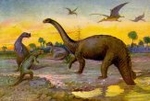
Worksheets and No Prep Teaching Resources
Reading Comprehension Worksheets
Dinosaurs

Dinosaurs
 Worksheets and No Prep Teaching Resources Reading Comprehension Worksheets Dinosaurs |
 Dinosaurs |
| edHelper's suggested reading level: | grades 6 to 7 | |
| Flesch-Kincaid grade level: | 6.02 |
|
Triceratops
By Sharon Fabian |

|
 1 Draw a Triceratops First, turn you paper sideways, then draw a really big head. It should take up almost a third of your paper and be shaped a little like a rhinoceros's head. Then draw a big, heavy body that takes up most of the rest of the page. Just leave room for four short legs and a tail.
1 Draw a Triceratops First, turn you paper sideways, then draw a really big head. It should take up almost a third of your paper and be shaped a little like a rhinoceros's head. Then draw a big, heavy body that takes up most of the rest of the page. Just leave room for four short legs and a tail. |
Create Weekly Reading Books
Prepare for an entire week at once! |
| Leave your feedback on Triceratops (use this link if you found an error in the story) |
 |
Dinosaurs
|
 |
Science
|